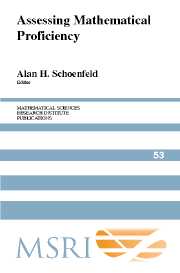Book contents
- Frontmatter
- Contents
- Preface
- Acknowledgments
- Section 1 The Big Picture
- Section 2 Perspectives on Mathematical Proficiency
- Section 3 What Does Assessment Assess? Issues and Examples
- Section 4 The Case of Algebra
- Section 5 What Do Assessments Assess? The Case of Fractions
- Section 6 The Importance of Societal Context
- 17 Assessment in France
- 18 Assessment to Improve Learning in Mathematics: The BEAR Assessment System
- 19 English Learners and Mathematics Learning: Language Issues to Consider
- 20 Beyond Words to Mathematical Content: Assessing English Learners in the Mathematics Classroom
- 21 Assessment in the Real World: The Case of New York City
- 22 Perspectives on State Assessments in California: What You Release Is What Teachers Get
- Epilogue: What Do We Need to Know? Items for a Research Agenda
- About the Authors
- Subject Index
- Author Index
- Task Index
21 - Assessment in the Real World: The Case of New York City
Published online by Cambridge University Press: 06 July 2010
- Frontmatter
- Contents
- Preface
- Acknowledgments
- Section 1 The Big Picture
- Section 2 Perspectives on Mathematical Proficiency
- Section 3 What Does Assessment Assess? Issues and Examples
- Section 4 The Case of Algebra
- Section 5 What Do Assessments Assess? The Case of Fractions
- Section 6 The Importance of Societal Context
- 17 Assessment in France
- 18 Assessment to Improve Learning in Mathematics: The BEAR Assessment System
- 19 English Learners and Mathematics Learning: Language Issues to Consider
- 20 Beyond Words to Mathematical Content: Assessing English Learners in the Mathematics Classroom
- 21 Assessment in the Real World: The Case of New York City
- 22 Perspectives on State Assessments in California: What You Release Is What Teachers Get
- Epilogue: What Do We Need to Know? Items for a Research Agenda
- About the Authors
- Subject Index
- Author Index
- Task Index
Summary
This chapter is devoted to a story from a city whose districts have faced and continue to grapple with huge challenges in helping teachers enable students from diverse backgrounds to achieve at high levels. My story is about one of the largest school systems in the United States and how it weathered storms of assessment and accountability. It begins in the hot political climate of the late 1960s.
New York City communities were clamoring for more control over their local schools. Turmoil over local control of schools in East Harlem and Ocean-Hill Brownsville sparked legislative action that resulted in the creation of thirty-two community school districts, each reflecting the unique local needs, interests, and cultural concerns of the neighborhoods that comprised them. The once allpowerful Central City Board of Education was replaced with local control, giving the districts the power to implement curriculum as it reflected local culture, and make decisions about how schools were to deliver education to neighborhood students.
The Central Board remained with a much narrower set of responsibilities, primarily focused on policy and accountability. It was responsible for setting standards, providing guidelines and support for instruction, and providing the public with test scores to reflect how successful schools were in meeting the standards. As part of the 1969 Decentralization Law, the Board was to hire a chancellor, whose responsibilities included monitoring achievement of schools in the newly created community school districts.
- Type
- Chapter
- Information
- Assessing Mathematical Proficiency , pp. 353 - 356Publisher: Cambridge University PressPrint publication year: 2007



